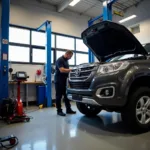Fixing a damaged front door plastic cover can seem daunting, but with the right approach, it’s often a manageable DIY project. Whether it’s a minor scuff or a more significant crack, understanding the repair process can save you a trip to the auto shop. This guide provides a comprehensive walkthrough on How To Repair Front Door Plastic Cover Of Car, from assessing the damage to choosing the right repair method.
Assessing the Damage to Your Car Door’s Plastic Cover
The first step in any car door plastic cover repair is to accurately assess the damage. This helps determine the best course of action and the necessary materials. Minor scratches might only require a simple buffing, while deeper cracks or dents might necessitate filling and repainting. Carefully inspect the affected area, noting the size, depth, and type of damage. Is it a simple scratch, a deep gouge, or a cracked piece of plastic? This initial assessment is crucial for a successful repair.
 Assessing the Damage to a Car Door Plastic Cover
Assessing the Damage to a Car Door Plastic Cover
Gathering Your Repair Materials
Once you’ve assessed the damage, gather the necessary materials. This will vary depending on the extent of the repair, but common items include cleaning solutions, sandpaper, plastic filler (if needed), primer, paint that matches your car’s color, clear coat, and various applicators like brushes, sponges, and masking tape. Having everything prepared beforehand streamlines the process.
Cleaning and Preparing the Damaged Area
Thoroughly cleaning the damaged area is crucial for proper adhesion of repair materials. Use a dedicated automotive cleaning solution to remove dirt, grease, and wax. After cleaning, lightly sand the damaged area and surrounding surface with fine-grit sandpaper to create a smooth surface for the repair materials to adhere to. This crucial step ensures a professional-looking finish.
Repairing Minor Scratches and Scuffs
For minor scratches and scuffs, a simple buffing compound might be all you need. Apply the compound to a clean microfiber cloth and rub the affected area in a circular motion. This can often restore the plastic’s original shine and make minor imperfections disappear.
Repairing Deeper Cracks and Gouges
Deeper cracks and gouges require more extensive repair. After cleaning and sanding, apply a plastic filler to the damaged area, following the manufacturer’s instructions. Once the filler dries, sand it smooth and blend it seamlessly with the surrounding surface. This prepares the area for priming and painting.
Priming and Painting the Repaired Area
Once the filler is sanded smooth, apply a thin coat of primer to the repaired area. This helps the paint adhere properly and provides a uniform base. After the primer dries, apply several thin coats of paint that matches your car’s color, allowing each coat to dry before applying the next. Finish with a clear coat to protect the paint and restore the original shine.
 Priming and Painting the Repaired Area of the Car Door
Priming and Painting the Repaired Area of the Car Door
Conclusion
Repairing the front door plastic cover of your car can be a satisfying DIY project. By carefully assessing the damage, following the correct repair procedures, and using the appropriate materials, you can restore your car’s appearance and potentially save money. Remember to prioritize safety and use proper protective gear throughout the process. Knowing how to repair front door plastic cover of car empowers you to address these common issues effectively.
FAQ
- What is the best way to clean the plastic cover before repair?
- Can I use any type of paint for the repair?
- How long does the plastic filler take to dry?
- What type of sandpaper should I use for sanding the filler?
- Do I need to apply a clear coat after painting?
- How to repair plastic car molding?
- Where can I find paint that matches my car’s color?
Common Situations
- Scratches from car washes: These are usually superficial and can be buffed out.
- Scuffs from minor impacts: These might require filler and repainting.
- Cracks from more significant impacts: These require careful filling, sanding, and repainting.
Further Assistance
For more information on car repairs, you can explore our article on how to repair plastic car molding.
Contact us on WhatsApp: +1(641)206-8880 or Email: [email protected] for 24/7 support. Our dedicated team is ready to assist you with any car repair needs.


